#Styracosaurus albertensis
Text


THE MOST METAL-PUNK DINOSAUR OF THE ENTIRE LATE CRETACEOUS? -- STAY HEAVY!
PIC(S) INFO: Spotlight on Styracosaurus albertensis; Late Cretaceous (75.5–75 Ma); Marginocephalia (ceratopsian); Described by Lamb, c. 1913; Artwork by William Stout, featured in his deluxe art book, "William Stout: Prehistoric life Murals" (2008), published by Flesk.
PIC #2: Cover art to "Prehistoric Times" magazine #44, published October/November 2000, also utilizing the Styracosaurus painting for its cover art.
Sources: www.williamstout.com/news/journal/product/prehistoric-times-44 & Pinterest.
#Prehistoric Times#Styracosaurus#Prehistoric Animals#Prehistoric Art#Palaeo Art#Palaeo Artist#William Stout#William Stout Artist#William Stout Art#Prehistoric#Dinosaur Art#Dinosaurs#Dinosaur#Prehistoric Times Magazine#Prehistoric Times magazine#Flesk#Styracosaurus albertensis#Ceratopsian#William Stout: Prehistoric life Murals#Herbivorous Ceratopsian Dinosaur#Flesk Publications#Marginocephalia#Late Cretaceous#Paleoart#Paleo Art#Palaeoart#Spiked lizard#Cerotopsidae#Marginocephalia Ceratopsian#Dinos
13 notes
·
View notes
Photo


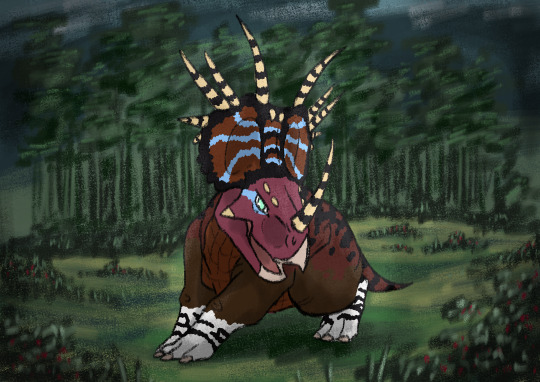

I had some spare time so I designed my dino.
I'm still not 100% satisfied with the colors, but It's starting to look promising.
I really love Ceratopsids they are my favorite group of dinos.
Enjoy!
#styracosaurus#dinosaur#dino#own character#OC#ceratopsian#Ceratopsids#animal#Illustration#art#digital art#painting#Styracosaurus albertensis#design
0 notes
Text

Quick doodle of my favourite character from Dinosauria by Dead Sound (David James Armsby) on youtube.
#A beautiful animated series on dinosaurs's lifes#dead sound#Dinosauria series#Dinosauria#My shit#Old buck film#David Armsby#Styracosaurus albertensis
25 notes
·
View notes
Text

One of my first pieces of paleoart, but still one of my favorites: Styracosaurus albertensis.
#illustration#paleoart#art#paleontology#paleo#sciart#artistsontumblr#digitalart#science#digitalillustration#styracosaurus#cretaceous
608 notes
·
View notes
Text

Strange Symmetries #17: Spiky Surprise
Styracosaurus albertensis was a ceratopsid dinosaur living during the late Cretaceous about 75 million years ago, in what is now Alberta, Canada. Around 5m long (~16'), it was one of the most elaborately ornamented horned dinosaurs, with a long nose horn and multiple elongated spikes on its frill.
There was actually quite a lot of variation in the frills of Styracosaurus, with varying numbers of long spikes and extra hook-like projections present on some individuals. But one recently-discovered specimen nicknamed "Hannah" is especially surprising – it had a noticeable amount of asymmetry in its skull. The left and right sides show different numbers and arrangements of spikes, so much so that if the two halves had been discovered separately they might have been identified as belonging to two completely different species.
Frill arrangements are often used to define different ceratopsids, so if this level of individual variation and asymmetry existed in other species, too, then we may need to reevaluate some of them.
———
NixIllustration.com | Tumblr | Twitter | Patreon
#science illustration#strange symmetries#paleontology#paleoart#palaeoblr#styracosaurus#centrosaurinae#ceratopsid#ceratopsia#marginocephalia#ornithischia#dinosaur#art
486 notes
·
View notes
Text
Styracosaurus albertensis portrait. I’m very sad today so I didn’t feel like doing a full body or background.
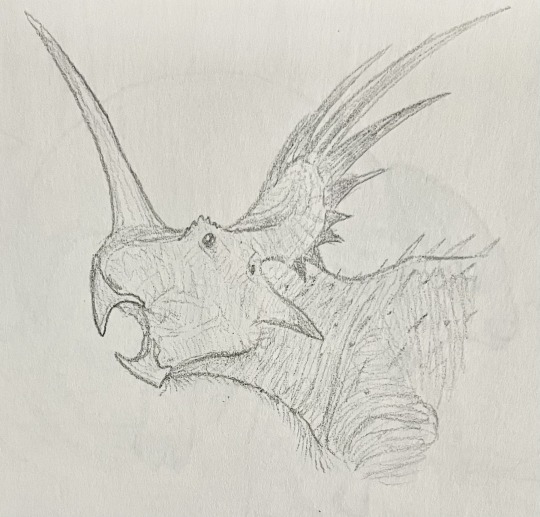
@1dinodaily
67 notes
·
View notes
Text

Wayne Barlowe. Styracosaurus albertensis. (The Horned Dinosaurs, by Peter Dodson, 1996)
908 notes
·
View notes
Text
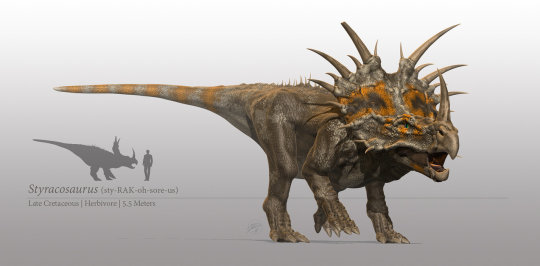
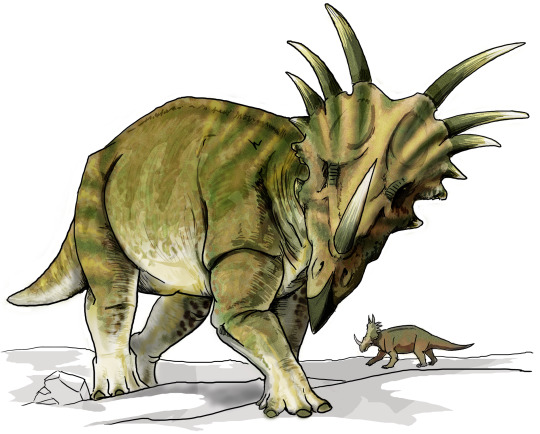
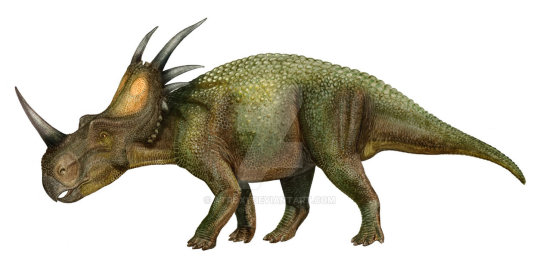
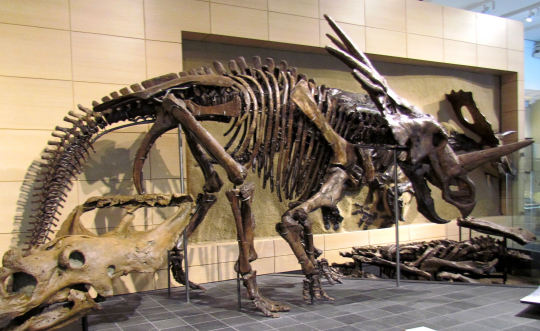

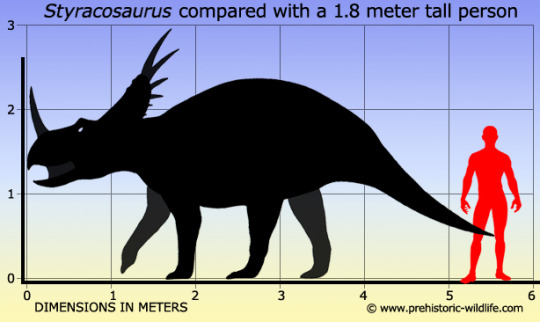
Styracosaurus
(temporal range: 75.5-74.5 mio. years ago)
[text from the Wikipedia article, see also link above]
Styracosaurus (/stɪˌrækəˈsɔːrəs/ sti-RAK-ə-SOR-əs; meaning "spiked lizard" from the Ancient Greek styrax/στύραξ "spike at the butt-end of a spear-shaft" and sauros/σαῦρος "lizard")[1] is a genus of herbivorous ceratopsian dinosaur from the Cretaceous Period (Campanian stage), about 75.5 to 74.5 million years ago. It had four to six long parietal spikes extending from its neck frill, a smaller jugal horn on each of its cheeks, and a single horn protruding from its nose, which may have been up to 60 centimeters (2 feet) long and 15 centimeters (6 inches) wide. The function or functions of the horns and frills have been debated for many years.
Styracosaurus was a relatively large dinosaur, reaching lengths of 5–5.5 metres (16–18 ft) and weighing about 1.8–2.7 metric tons (2.0–3.0 short tons). It stood about 1.8 meters (5.9 feet) tall. Styracosaurus possessed four short legs and a bulky body. Its tail was rather short. The skull had a beak and shearing cheek teeth arranged in continuous dental batteries, suggesting that the animal sliced up plants. Like other ceratopsians, this dinosaur may have been a herd animal, travelling in large groups, as suggested by bone beds.
Named by Lawrence Lambe in 1913, Styracosaurus is a member of the Centrosaurinae. One species, S. albertensis, is currently assigned to Styracosaurus. Another species, S. ovatus, named in 1930 by Charles Gilmore was reassigned to a new genus, Rubeosaurus, by Andrew McDonald and Jack Horner in 2010,[2] but it has been considered either its own species or a species of Styracosaurus (or even a specimen of S. albertensis)[3] again, since 2020.
9 notes
·
View notes
Text
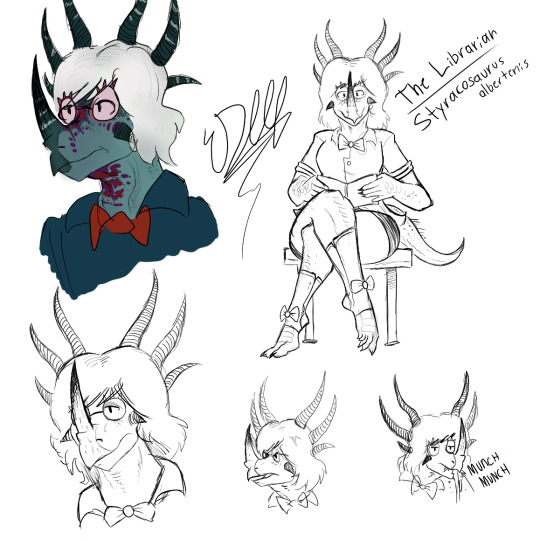
Colored headshot and posing/expression doodles for The Librarian, who's a clone descedant of Styracosaurus albertensis.
She's someone who usually keeps to herself, but for what reason? Well, she's quite interested in the study of her genome ancestors, the dinosaurs. Afterall, you can't do a lot of studying if you're interrupted by other dinosauroids and their shenanigans. Alternatively, if she's continously pestered, a stern display with her massive nasal horn will usually shut down such behavior.
(This is especially effective if you have horns reaching 2' in size, and a staggering height of 14'.
#art#artwork#artists on tumblr#character art#character concept#original character#dinosaur#monster girl#dinosaur girl#dinosaur oc#dinosauroid#anthro#styracosaurus#ceratopsian#triceratops#horned lizard#monster girls#horns#tall girls#pose#posing practice#posing
11 notes
·
View notes
Text
Gonna do a drawing study on the evolution of pachyrhinosaurus starting with Styracosaurus albertensis, then S. ovatus, Stellasaurus ancellae, Einiosaurus procurvicornis, Achelousaurus horneri, and finally all the pachyrhinosaurus species
4 notes
·
View notes
Text
On this episode of Scientists Being The Best:
David Armsby is the paleoartist behind the short film Old Buck (the first of his WIP Dinosauria series, available here), which focuses on a herd of Styracosaurus albertensis.
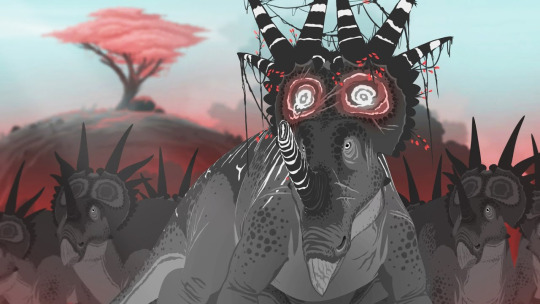
(Still directly from short film)
In David’s Making Of video, he explains that this choice of dinosaur was inspired by a particular fossil specimen of the same species, notable in that the rack of horns at the top of her frill was asymmetrical. This specimen, named UALVP55900 or, alternatively, Hannah, brought up a lot of questions about the classification of previous fossils - multiple other specimens have been named as different species due to different numbers or arrangements of horns, but this discovery raised the possibility that they could have all been natural variations of the same species.
The film references the theory that one of the previous specimens put into question was an extreme morph of the albertensis genus. The horns of the main character are directly based off of this specimen, and careful watchers will be able to spot the member of the herd with Hannah’s horn morph as well.
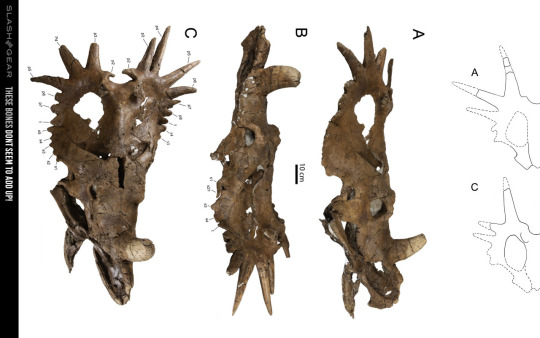
(Diagram of Hannah)
Old Buck was extremely successful in paleo-scientific circles due to its accuracy - and the fact that David acknowledges and readily points out any inaccuracies included for storytelling purposes. Because of this, it made its way all the way back to the scientists at the University of Alberta, where Hannah is being studied. And...

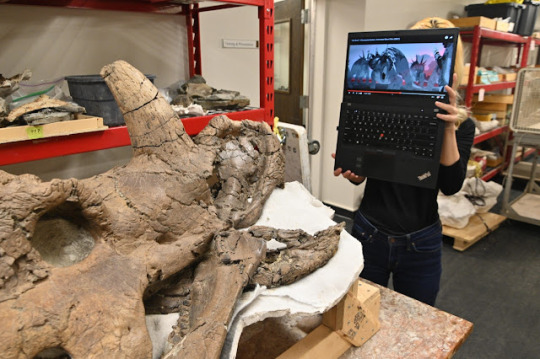
(Photo from David’s post on the subject)
...They showed the short film to the fossil. Naturally.
#i never make posts like this but. when dinosaur hyperfix hits it hits hard SDHSJH#dinosauria#i have so much love for this series#i could gush about it for much longer than this but ill save that rant for later KDSHDB#dinosauria series#styracosaurus#styracosaurus albertensis#UALVP55900#old buck#original post#dinosaurs#dinosaur#paleoart
1K notes
·
View notes
Text
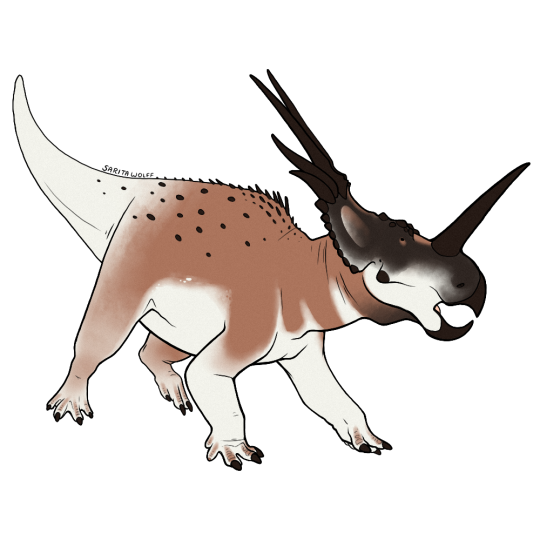
Archovember Day 16: Styracosaurus albertensis
Second only to Triceratops, Styracosaurus is undoubtedly the most famous ceratopsian, and for good reason. Instead of having three horns on its face, it had one impressively long forward-pointing nose horn and 4-6 large spikes jutting from its frill. While only about half the size of Triceratops, it was still a large animal, a bit bigger than a common hippopotamus.
As far as we know there are (maybe?) only two species of Styracosaurus, however, frill spikes have a lot of variation between individuals. On some, the spikes at the midline of the frill point towards each other, while on others they point outward. Some have 4 large frill spikes, while some have six. Some have smaller hooks on their frill alongside the spikes, while in others these are reduced. In one specimen, the frill horns are asymmetrical and look to have simply grown this way, and not been due to an injury.
S. albertensis lived in Cretaceous Alberta, Canada, alongside other ceratopsians Centrosaurus and Chasmosaurus, a variety of hadrosaur species, ankylosaurids Edmontonia and Euoplocephalus, and may have been preyed upon by the tyrannosaurids Gorgosaurus and Daspletosaurus (though neither of them would have stood a chance against a healthy full grown Styracosaurus.)
As a ceratopsian, Styracosaurus was likely a plant eater, but may have also scavenged carrion with its sharp beak.
#my art#Styracosaurus albertensis#Styracosaurus#ceratopsians#Ornithischians#dinosaurs#archosaurs#archosauromorphs#Archovember#Archovember 2021#Draw Dinovember#Draw Dinovember 2021#Dinovember#Dinovember 2021#SaritaDrawsPalaeo
87 notes
·
View notes
Photo

A beaten up old Styracosaurus bull looks on while a younger male sizes him up and postures a bit, trying to initiate a fight. But the elder is too old for this shit.
#styracosaurus#styracosaurus albertensis#ceratopsian#ceratopsid#dinosaur#cretaceous#paleoart#csp#clip studio paint
299 notes
·
View notes
Text
We are Unlocking The Past on Styracosaurus this Fossil Friday! Why are so many species assigned to this genus? Which dinosaurs did they replace from the area? Find out here!
Life reconstruction of Styracosaurus albertensis by Max Bellomio. Available at: https://www.artstation.com/artwork/Yalrld.
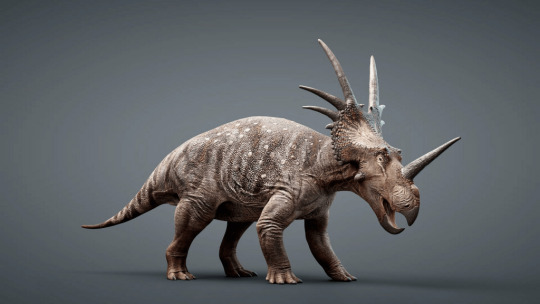
#palaeo#paleo#blog#fossil#geology#rocks#Styracosaurus albertensis#palaeontology#paleontology#paleoblr#palaeoblr#ceratopsians#biology#science#earth sciences#article#darwins door#unlockingthepast
25 notes
·
View notes
Link
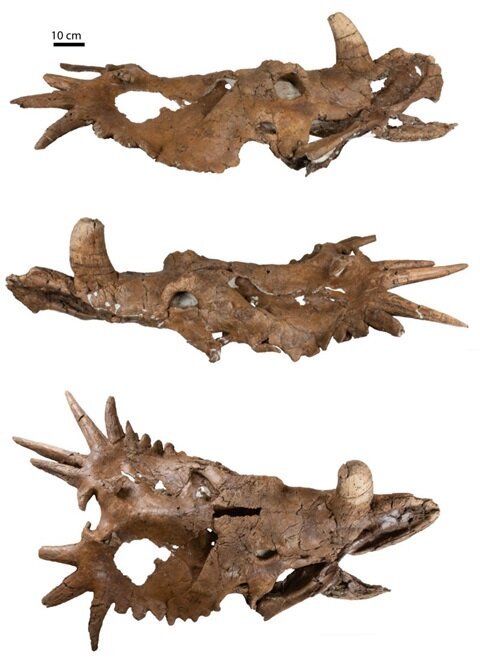
An article published in the journal "Cretaceous Research" reports a study of a fossil skull of Styracosaurus albertensis, a herbivorous dinosaur that lived in today's North America about 75 million years ago, in the Cretaceous period. A team of researchers led by Professor Robert Holmes of the University of Alberta, Canada, examined this well-preserved fossil noting that its horns were asymmetrical. Previously, no skull attributed to the genus Styracosaurus was complete enough to see that asymmetry. This discovery could lead to various reclassifications of fossils that over time were attributed to other species of the genus Styracosaurus and later even to other genera.
1 note
·
View note
Text
Styracosaurus albertensis
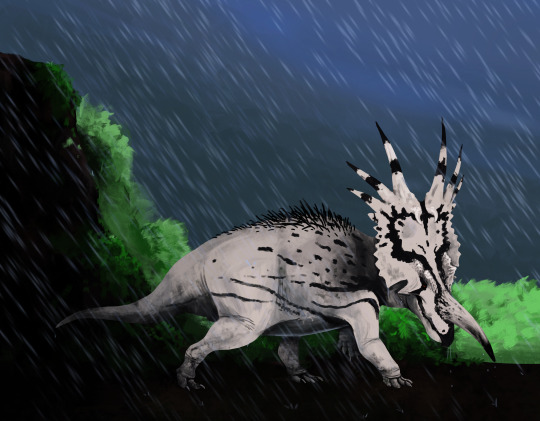
By Jack Wood on @thewoodparable
PLEASE support us on Patreon! We really do need all of your support to keep this blog running - any amount helps!
Name: Styracosaurus albertensis
Name Meaning: Spiked Reptile
First Described: 1913
Described By: Lambe
Classification: Dinosauria, Ornithischia, Genasauria, Neornithischia, Cerapoda, Marginocephalia, Ceratopsia, Neoceratopsia, Coronosauria, Ceratopsoidea, Ceratopsidae, Centrosaurinae, Centrosaurini
Styracosaurus is one of the more famous Ceratopsians, and and for good reason - it’s spectacular horns and frill mark it out as distinctive, and it is fairly well known as well, with many specimens collected and, back in the day, many species assigned to it - though all but the original have now since been assigned their own species. It was large, about 5.5 meters long, standing at about 1.8 meters tall at the hips, and weighing approximately 3 tonnes. It was originally found in the Dinosaur Park Formation of Alberta, Canada, and other specimens found elsewhere have been assigned their own genera. It lived about 75 million years ago, in the Campanian age of the Late Cretaceous.
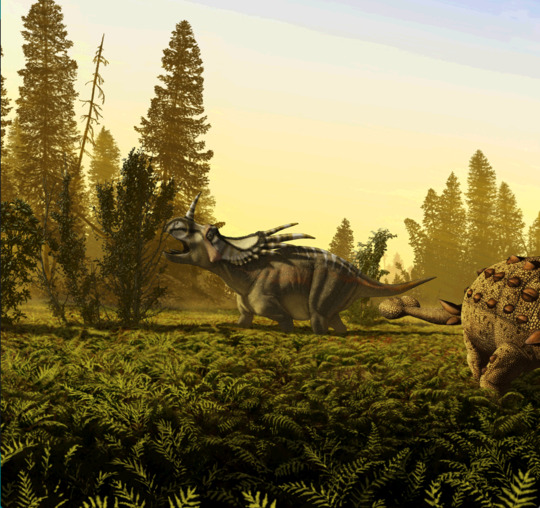
By Julius Cstonyi, CC BY 2.5
Styracosaurus is distinctive in their massive skulls, with large neck frills with at least four large spikes. These spikes were similar in length to the horn on its nose, which ended in a rounded point. It had other, more variable ornamentation on the frill, with small hook-like projections and knobs on the frill, or less prominent tabs, or a third pair of long spikes, or smaller projections. There were also small, pyramid like brow horns in subadults that would change to pits as the animal aged into an adult; the brow horns being remnants of the brow horns ancestral to all Ceratopsids. It had large openings in its frill, which may have served as platforms for display coloration. It had a toothless beak in the front of its mouth, like other Ceratopsians. It’s frill, in general, seems to have been better built for display, rather than defense; and is probably a remarkable example of the effects of sexual selection on Ceratopsians. It had a very bulky body, like that of modern rhinoceros, which would have allowed it to brace itself when fighting with other members of the species. It also had a very short tail, and hoof-like toe claws.

By Mariana Ruiz Villarreal, in the Public Domain
A bonebed of Styracosaurus individuals is known, but it is associated with varying river deposits, and it is possible that animals simply congregated there to drink during drought and were not truly herd animals. In short, direct evidence of herding behavior isn’t entirely known. It did not have sprawling forelimbs, as was once believed, and it may have been able to run faster than elephants, based on found trackways. It ate plants, though exactly what kind has been up to debate. Its large frill, as stated, was probably used for display rather than defense; this seems to be a common condition of Centrosaurines versus Ceratopsians more closely related to Triceratops, which appear to have used it for defense in addition to any display purposes.
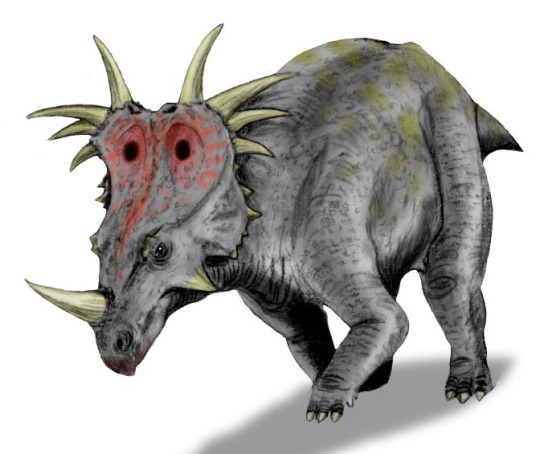
By Nobu Tamura, CC BY 3.0
Styracosaurus was a Centrosaurine, and it’s evolution amongst other Centrosaurines is very well known. It is probably the direct descendant of Centrosaurus, which came earlier, and it replaced Centrosaurus in the typical ecosystem of Late-Cretaceous North America in terms of niche, as the two are not found alongside one another. It then is thought to have evolved into the similar Rubeosaurus, which is known from slightly later. It is probably much more complex than this, however, the closeness in relation of all these species cannot be denied, especially given that Rubeosaurus was originally described as a species of Styracosaurus, and Styracosaurus shared many similar features to Centrosaurus.
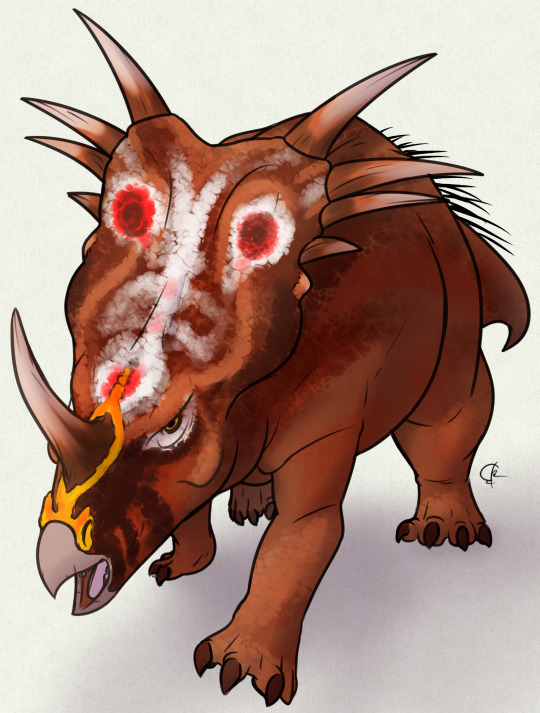
By José Carlos Cortés on @ryuukibart
Styracosaurus lived in a very diverse and complex community in the Dinosaur Park Formation with many famous dinosaurs, specifically Vagaceratops, Lambeosaurus, Prosaurolophus, Daspletosaurus, which may have preyed upon it, and others whose time in the formation is ambiguous. Troodon, Saurornitholestes, Richardoestesia, Hesperonychus, Dromaeosaurus, Leptorhynchos, Chirostenotes, Caenagnathus, Ornithomimus, Struthiomimus, Rativates, Stegoceras, Gravitholus, and Unescoceratops might have lived alongside it as well. It lived in a floodplain environment, near the coast of the Inland Sea that existed in Cretaceous at that time.
Sources:
https://en.wikipedia.org/wiki/Styracosaurus
https://en.wikipedia.org/wiki/Dinosaur_Park_Formation
Shout out goes to @bitchpleasescience!
#styracosaurus#styracosaurus albertensis#dinosaur#ceratopsian#palaeoblr#bitchpleasescience#paleontology#prehistory#prehistoric life#dinosaurs#biology#a dinosaur a day#a-dinosaur-a-day#dinosaur of the day#dinosaur-of-the-day#science#nature#factfile#Dìneasar#डायनासोर#ديناصور#ডাইনোসর#risaeðla#ڈایناسور#deinosor#恐龍#恐龙#динозавр#dinosaurio#공룡
124 notes
·
View notes